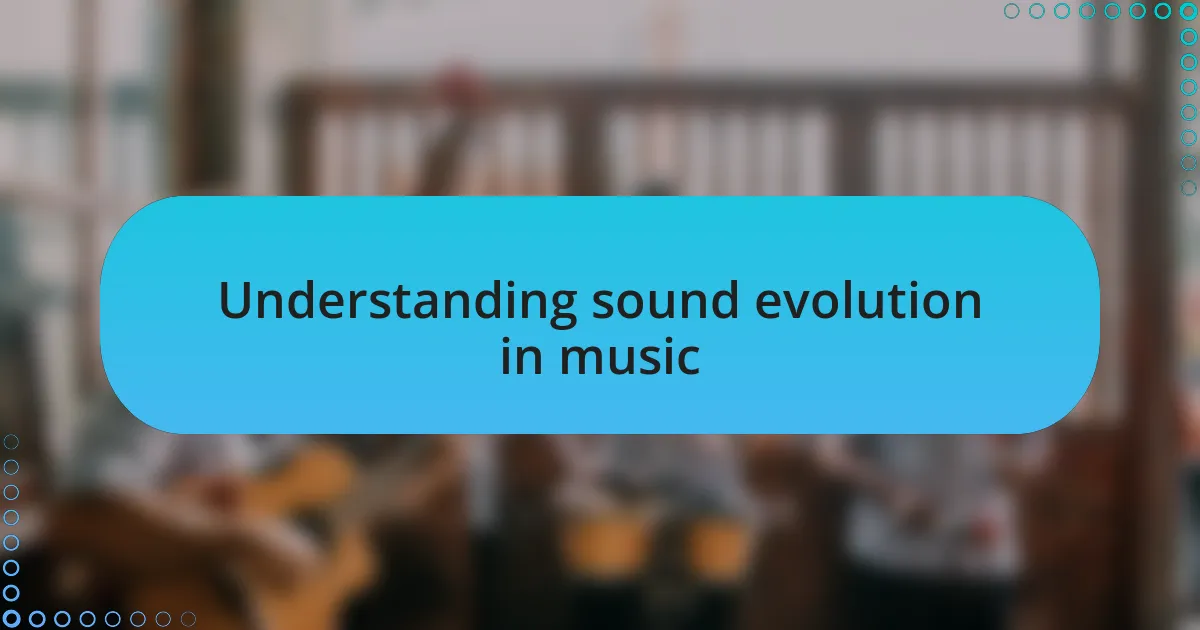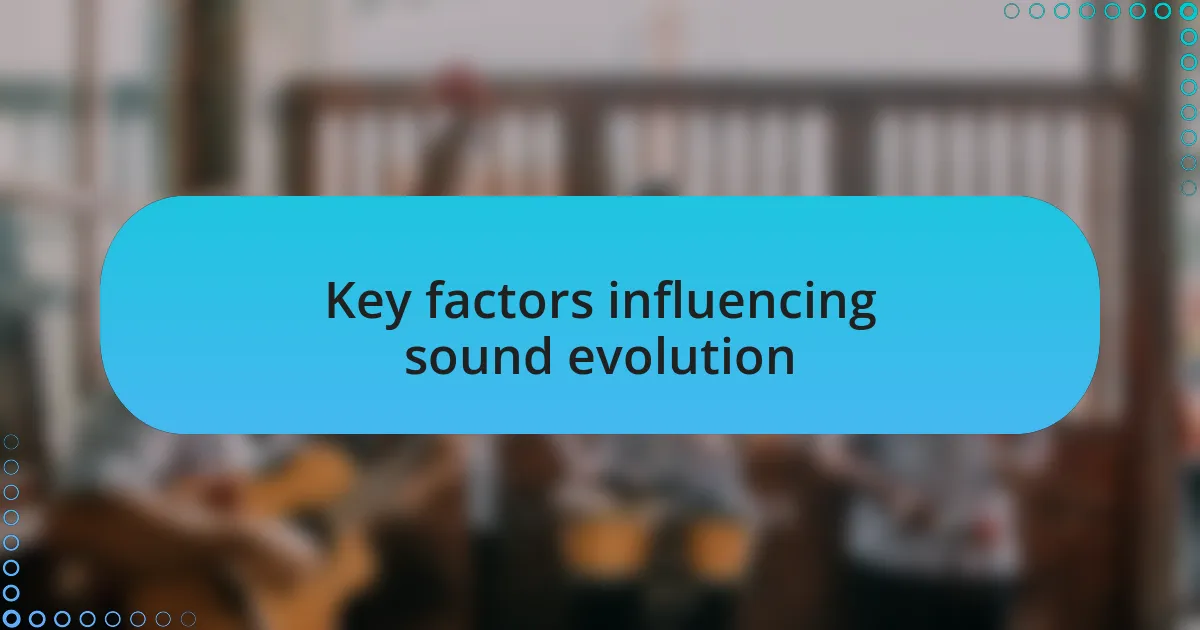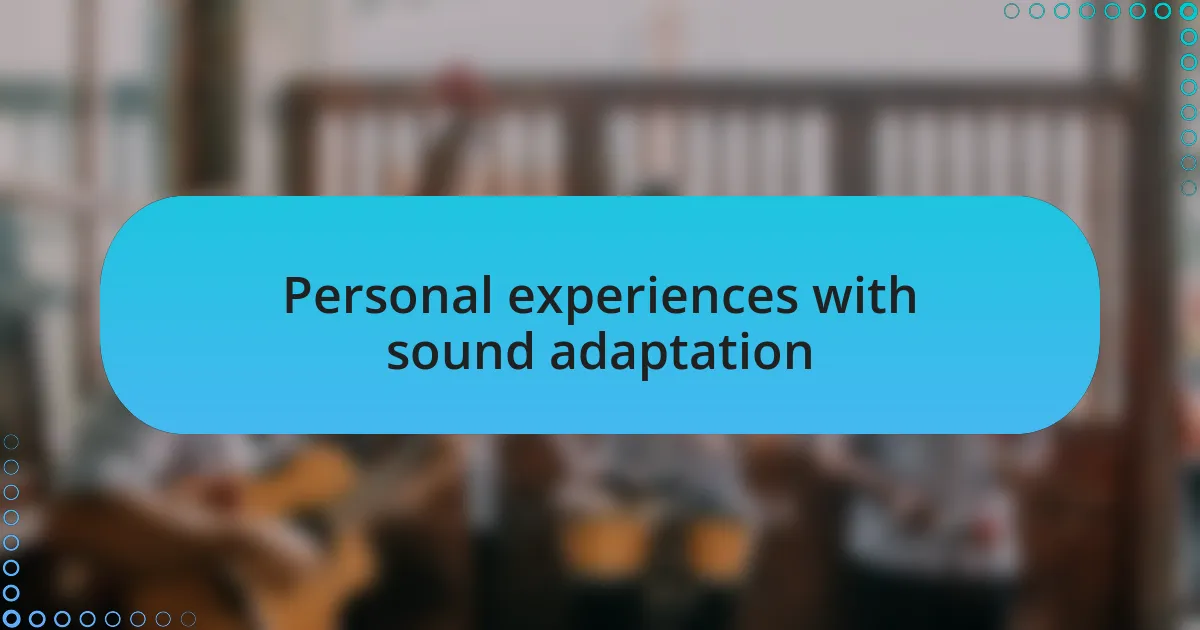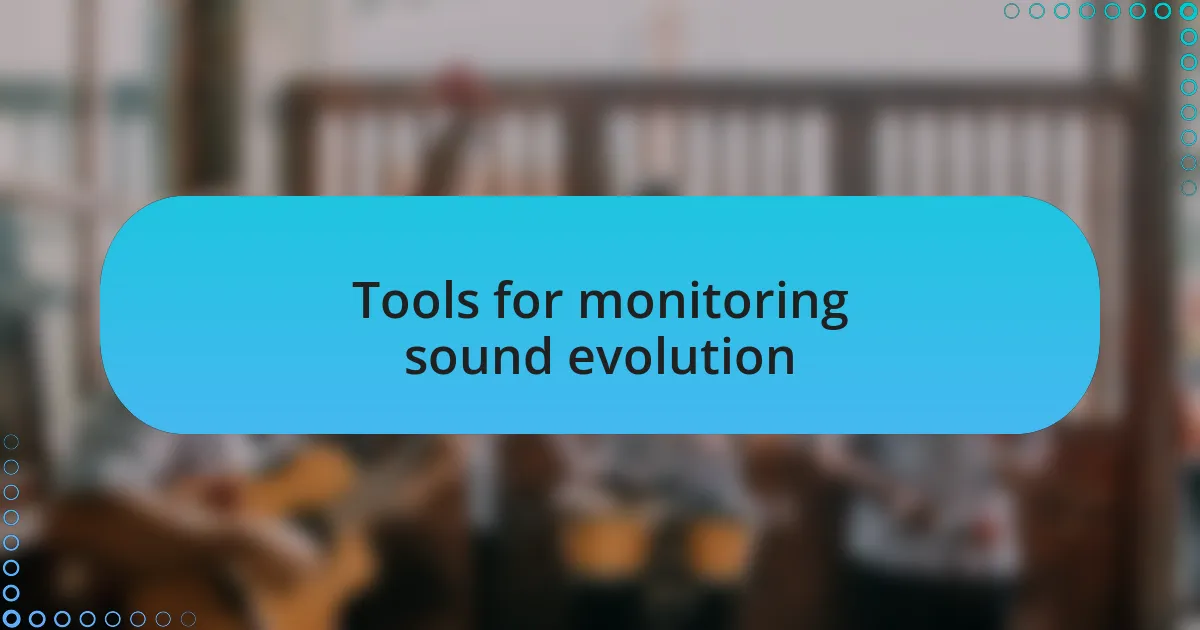Key takeaways:
- Technological innovation and cultural exchange are key factors driving sound evolution in music, allowing artists to experiment and collaborate across genres.
- Bands can adapt to changing musical landscapes by embracing new technologies, collaborating with other artists, and engaging with audience feedback to stay relevant.
- Personal experiences, such as experimenting with live-looping and balancing electronic and acoustic elements, illustrate how artists can explore new sonic possibilities and foster deeper connections with their music.
- Effective tools for monitoring sound evolution, like audio software and feedback platforms, enable artists to analyze changes and gather audience insights to enhance their creative journey.

Understanding sound evolution in music
Sound evolution in music is a fascinating journey that reflects societal changes and technological advancements. I often think back to the first time I heard a synth wave track; it was a refreshing shift from the traditional guitar-driven sounds. How did we get from the raw energy of rock to the polished layers of electronic music?
In my experience, each musical era has contributed distinct elements that shaped subsequent genres. For instance, the incorporation of jazz into rock during the late ’60s added complexity that still resonates today. It makes me wonder, what if certain musical styles hadn’t collided? Would we still have the rich tapestry of sounds that define contemporary music?
I find it particularly intriguing how modern artists reinterpret classic sounds. This blending of old and new creates a vibrant conversation between generations. When I listen to a song that samples a classic hit, I can’t help but feel connected to the past, sparking a sense of nostalgia and discovery at the same time. Isn’t it fascinating how music can evoke such strong emotions while continually evolving?

Key factors influencing sound evolution
One of the key factors influencing sound evolution is technological innovation. I still vividly remember the first time I experienced music production software. It opened a world of possibilities that were previously confined to professional studios. How many groundbreaking tracks have been created simply because an artist could access sophisticated tools at home? The accessibility of technology has not only shifted how music is made but also who gets to make it.
Cultural exchange plays a significant role as well. Reflecting on my own experiences at music festivals, I’ve witnessed the fusion of diverse musical styles. For example, seeing traditional African rhythms integrated into contemporary pop was a powerful reminder of how cultures influence each other. Isn’t it amazing how one beat can transcend borders and create a universal language? This exchange encourages artists to experiment and push boundaries, leading to exciting new sounds.
Finally, changing social dynamics affect what sounds become popular. I recall the rise of protest songs during turbulent times in history; they often served as anthems for change. Music is a mirror reflecting societal concerns, and as our values shift, so does our sound. What does it say about us when certain genres dominate? In many ways, sound evolution tells the story of who we are at any given moment in time.

Strategies for bands to adapt
Adapting to sound evolution requires bands to embrace new technologies and trends thoughtfully. I remember when I first experimented with digital instruments; the soundscapes we could create were extraordinary. How often do bands take a leap into modern production techniques that could expand not only their sound but also their fanbase? Investing time in learning these tools can redefine a band’s musical identity.
Collaboration is another powerful strategy for adaptability. I once joined forces with a local electronic artist, and the outcome was something neither of us could have created alone. By merging our styles, we uncovered a fresh sound that we hadn’t initially envisioned. Isn’t it fascinating how collaboration can lead to creativity that feels organic and groundbreaking at the same time?
Regularly engaging with audience feedback is crucial for bands aiming to stay relevant. I’ve attended shows where the band’s willingness to play rearranged versions of their hits based on fan reactions created an electric atmosphere. Listening to what fans want doesn’t mean compromising artistic integrity; it’s about understanding how your audience connects with your music. How can we evolve if we ignore the voices of those who support us? By fostering this dialogue, bands can create music that resonates deeply and continually evolves.

Personal experiences with sound adaptation
As I navigated my journey through sound evolution, one moment stands out vividly. I remember attending a workshop where we experimented with live-looping techniques. The rush of layering sounds in real-time opened my eyes to how we could transform even the simplest melody into a multi-dimensional experience. Have you ever felt that thrill when you unexpectedly uncover new possibilities in your sound? It’s electrifying.
During a particularly challenging phase, I turned to acoustic elements to balance our more electronic-focused tracks. I felt a deep connection to the rawness of live instruments, which allowed me to express emotions I hadn’t realized were bottled up inside. Isn’t it interesting how shifting our sonic palette can evoke such profound personal reflections? It’s as if music continues to teach us about ourselves as we adapt.
I also recall a night spent at a local venue, where the band unleashed a new song inspired by the sounds of street performers we had encountered earlier that week. Seeing the audience connect with our adaptation in real-time was an awakening. It made me question: how often do we allow the world around us to shape our music? That evening solidified my belief that the environment we inhabit is rich with inspiration, waiting for us to adapt and resonate within our creations.

Tools for monitoring sound evolution
Monitoring sound evolution relies heavily on various tools that can capture and analyze audio changes over time. In my experience, software like Ableton Live has been instrumental. Its ability to visualize sound waves and manipulate audio in real-time allows me to hear shifts I might otherwise miss. Have you explored how live audio manipulation can lead to unexpected sound discoveries?
Another tool that has truly shifted my approach is a dedicated audio interface. Using it, I can record my band with higher fidelity, revealing nuances in our sound. I recall when we first switched to a better interface, the difference was astonishing. It felt like we were hearing ourselves for the first time. Isn’t it fascinating how the right technology can breathe new life into your music?
Lastly, I can’t overlook the importance of feedback platforms, such as SoundCloud or Bandcamp, where artists share their work and receive immediate audience reactions. I remember uploading a track and having listeners comment on subtle changes I was unsure about. It reminded me that sound evolution isn’t just about technical tools; it’s also about connecting with others who inspire and challenge our creative journey. How do you integrate feedback into your own sound development?